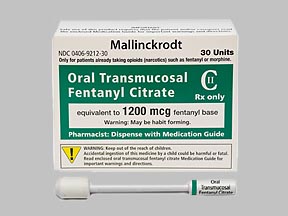
Actiq Coupons & Savings Card – Discount Prices from $339.90
Brand for: Fentanyl
My prescription
Edit
1200MCG, Fentanyl (30 Lozenge on a Handles)
Select pharmacy

CVS
$422.85
COUPON PRICE
Walgreens
$339.90
COUPON PRICE
Albertsons
$347.00
COUPON PRICEFree Actiq Savings Card

Walgreens
$339.90
Show this coupon to your pharmacist
ID
LHET727394
PCN
GDC
BIN
015995
GRP
GDRX
This coupon is not insurance
Related opioids prescriptions
More prescriptions for pain
Related opioids prescriptions
More prescriptions for pain
Actiq (Fentanyl) dosage forms
Dosage Quantity Price from Per unit 200MCG 30 Lozenge on a Handles $337.50 $11.25 200MCG 60 Lozenge on a Handles $666.00 $11.10 200MCG 90 Lozenge on a Handles $994.50 $11.05 400MCG 30 Lozenge on a Handles $264.60 $8.82 400MCG 60 Lozenge on a Handles $520.20 $8.67 400MCG 90 Lozenge on a Handles $775.80 $8.62 600MCG 30 Lozenge on a Handles $339.30 $11.31 600MCG 60 Lozenge on a Handles $669.60 $11.16 600MCG 90 Lozenge on a Handles $999.90 $11.11 800MCG 30 Lozenge on a Handles $384.90 $12.83
| Dosage | Quantity | Price from | Per unit |
|---|---|---|---|
| 200MCG | 30 Lozenge on a Handles | $337.50 | $11.25 |
| 200MCG | 60 Lozenge on a Handles | $666.00 | $11.10 |
| 200MCG | 90 Lozenge on a Handles | $994.50 | $11.05 |
| 400MCG | 30 Lozenge on a Handles | $264.60 | $8.82 |
| 400MCG | 60 Lozenge on a Handles | $520.20 | $8.67 |
| 400MCG | 90 Lozenge on a Handles | $775.80 | $8.62 |
| 600MCG | 30 Lozenge on a Handles | $339.30 | $11.31 |
| 600MCG | 60 Lozenge on a Handles | $669.60 | $11.16 |
| 600MCG | 90 Lozenge on a Handles | $999.90 | $11.11 |
| 800MCG | 30 Lozenge on a Handles | $384.90 | $12.83 |
| 800MCG | 60 Lozenge on a Handles | $760.80 | $12.68 |
| 800MCG | 90 Lozenge on a Handles | $1136.70 | $12.63 |
| 1200MCG | 30 Lozenge on a Handles | $474.60 | $15.82 |
| 1200MCG | 60 Lozenge on a Handles | $940.20 | $15.67 |
| 1200MCG | 90 Lozenge on a Handles | $1405.80 | $15.62 |
| 1600MCG | 30 Lozenge on a Handles | $669.30 | $22.31 |
| 1600MCG | 60 Lozenge on a Handles | $1329.60 | $22.16 |
| 1600MCG | 90 Lozenge on a Handles | $1989.90 | $22.11 |
Actiq Warnings
Fentanyl carries significant safety concerns and requires careful usage to prevent serious health risks. Below are key safety and warning points you should consider before using this medication. Always consult your healthcare provider for advice tailored to your specific circumstances.
Risk of Abuse and Addiction: Fentanyl can be addictive, even when used as prescribed. Misuse can lead to overdose and death. Your doctor will prescribe the lowest effective dose for the shortest duration to minimize these risks. Store fentanyl securely to prevent unauthorized use.
Breathing Problems: Fentanyl may cause severe, potentially fatal respiratory depression. This risk is heightened during the initial 24 to 72 hours of use, with dose increases, or when switching between fentanyl forms. If you experience slow or shallow breathing, seek medical help immediately.
Accidental Overdose: Overdose can occur at prescribed doses if taken accidentally by others, especially children. Store fentanyl in a secure location and follow proper disposal instructions. If accidental ingestion occurs, seek medical attention immediately.
Interactions with Other Substances: Combining fentanyl with alcohol, benzodiazepines, sleep aids, or other opioids can severely depress brain function, causing extreme drowsiness, respiratory issues, coma, or death. Inform your healthcare provider of all medications you are taking to avoid harmful interactions.
Safety Precautions for Specific Populations:
- Pregnant individuals should use fentanyl only if necessary, as it poses risks to the unborn child, including withdrawal symptoms at birth.
- Elderly patients and those with pre-existing respiratory or heart conditions should be cautious, as they are at higher risk for side effects.
- Patients with a history of substance abuse or mental health conditions should discuss these with their healthcare provider due to increased risk of misuse and addiction.
Emergency Actions for Overdose: If signs of overdose appear—such as severe drowsiness, difficulty waking, slow or shallow breathing—seek emergency medical help immediately. Have naloxone available and ensure family members know how to use it in case of an overdose.
Serotonin Syndrome: Using fentanyl with serotonergic drugs can cause serotonin syndrome, a potentially life-threatening condition. Symptoms include agitation, hallucinations, rapid heart rate, and muscle rigidity. Discontinue use and seek immediate medical care if symptoms occur.
Withdrawal in Newborns: Prolonged use during pregnancy may cause neonatal opioid withdrawal syndrome in newborns, characterized by high-pitched crying, poor feeding, and seizures. Immediate medical intervention is necessary.
Low Hormone Levels and Blood Pressure Issues: Long-term use can lead to adrenal insufficiency and low blood pressure, causing symptoms like dizziness and fainting. Consult your healthcare provider if you experience these symptoms.
Seizures: Fentanyl may increase seizure risk in individuals with a history of seizures. Notify your provider if your seizures worsen.
Contraindications: Do not use fentanyl if you are not opioid-tolerant, have severe respiratory issues, are treating short-term pain, have severe asthma, or have a stomach or intestinal blockage.
By understanding these safety measures and risks, you can use fentanyl more safely and effectively. Always adhere to your healthcare provider's guidance and report any concerning symptoms or side effects promptly.
Actiq Side Effects
When using this medication, some individuals may experience common side effects such as nausea, weakness, vomiting, constipation, headache, dizziness, anxiety, and sleepiness. These effects are generally mild and may improve over time. If they persist or worsen, it's advisable to consult a healthcare provider. To manage constipation, consider increasing dietary fiber, staying hydrated, and exercising regularly. Rising slowly from sitting or lying positions can help reduce dizziness and lightheadedness. There are other side effects, including accidental injury, muscle stiffness, confusion, depression, trouble sleeping, dry mouth, abnormal walking, nervousness, rash, and sweating. While these are less common, it's important to monitor your symptoms and reach out to a healthcare provider if they become severe. Serious side effects, though rare, require immediate medical attention. These include symptoms like fainting, seizures, slow or shallow breathing, severe drowsiness, or difficulty waking up. Overdose symptoms may include unresponsiveness, slowed breathing, muscle weakness, small pupils, cold or clammy skin, slow heart rate, or coma. Allergic reactions, such as hives, swelling of the lips, tongue, face, or eyes, shortness of breath, or chest tightness, also necessitate urgent medical help. In rare cases, this medication may lead to serotonin syndrome, especially if combined with other serotonin-increasing drugs. Symptoms include a rapid heartbeat, hallucinations, loss of coordination, severe nausea, vomiting, diarrhea, twitching muscles, unexplained fever, and severe dizziness. Additionally, watch for signs of adrenal insufficiency, such as nausea, vomiting, stomach pain, low appetite, and fatigue. Withdrawal symptoms can also occur, characterized by restlessness, runny nose, yawning, sweating, chills, and anxiety. Should you notice any other side effects, or if you have concerns, contacting a healthcare professional is recommended for guidance and support.
Actiq Interactions
Fentanyl (Actiq) can interact with various medications and supplements, so it's crucial to inform your healthcare provider about all the substances you're currently taking, including prescription, over-the-counter medications, and herbal supplements. Here are some important points regarding potential interactions:
Medications to Avoid: Some drugs should not be used with fentanyl due to the risk of serious interactions. These include Mifepristone, nalmefene, Naltrexone, and safinamide. Your doctor might choose alternative treatments if you're taking these.
Medications to Use Cautiously: Certain medications may still be necessary but require careful monitoring and potentially adjusted dosages if used with fentanyl. These include a wide range of drugs such as azole antifungals (like Itraconazole, Ketoconazole), calcium channel blockers (like diltiazem, Verapamil), HIV protease inhibitors (such as nelfinavir), macrolide antibiotics (such as Erythromycin), and others. It is important to consult your doctor if you are using any of these.
Risk of Serious Side Effects: Combining fentanyl with other substances that cause drowsiness or breathing difficulties can increase the risk of severe side effects like slow or shallow breathing and extreme drowsiness. These substances include other opioids (such as codeine, hydrocodone), alcohol, cannabis, sleep or anxiety medications (like Alprazolam, Lorazepam), muscle relaxants (such as Carisoprodol, Cyclobenzaprine), and some antihistamines (such as Cetirizine, diphenhydramine).
Serotonin Syndrome Risk: Some medications that increase serotonin levels can lead to serotonin syndrome when combined with fentanyl. This includes some antidepressants (SSRIs like Fluoxetine and SNRIs like Duloxetine), as well as other substances like MDMA and St. John's wort. The risk is particularly high when starting or increasing the dose of these drugs.
MAO Inhibitors Warning: Using MAO inhibitors with fentanyl can cause a potentially fatal interaction. If you're on MAO inhibitors such as isocarboxazid, Linezolid, or others, you should not use fentanyl until two weeks after stopping these medications. Always consult your doctor for guidance.
Lab Test Interference: Fentanyl may affect certain lab tests, potentially leading to inaccurate results. Inform your lab personnel and doctors about your fentanyl use to ensure accurate testing.
Be sure to check all medication labels, especially for allergy or cold products, which may contain ingredients that cause drowsiness. For safety, always discuss with your pharmacist before using new medications.
What is the drug Actiq used for?
Actiq is used for the management of breakthrough pain in cancer patients who are already receiving and are tolerant to opioid therapy for their underlying persistent cancer pain. It is specifically designed for patients who require additional pain relief despite their regular opioid regimen.
Is Actiq a controlled substance?
Yes, Actiq is a controlled substance. It is classified as a Schedule II controlled substance in the United States due to its high potential for abuse and risk of severe psychological or physical dependence.
How much does Actiq cost?
The cost of Actiq can vary significantly based on factors such as dosage strength, quantity, pharmacy location, and whether the patient has insurance coverage. Without insurance, the price can be quite high, often several hundred dollars for a supply. It is advisable for patients to check with their local pharmacy for the most accurate and up-to-date pricing and to consult with their insurance provider to understand coverage options. Additionally, some pharmaceutical companies offer patient assistance programs that may help reduce the cost.
What is Actiq prescribed for?
Actiq is prescribed for the management of breakthrough pain in cancer patients who are already receiving and are tolerant to opioid therapy for their underlying persistent cancer pain.
